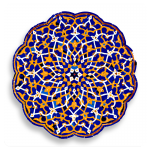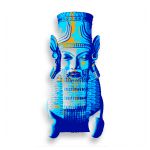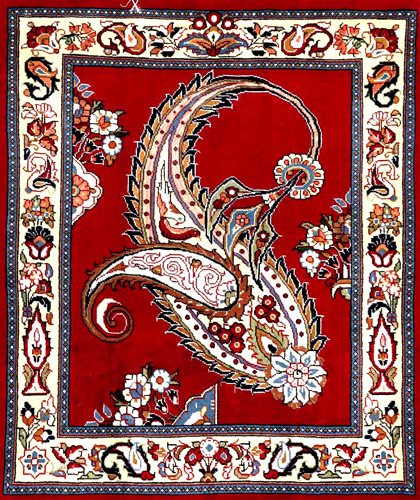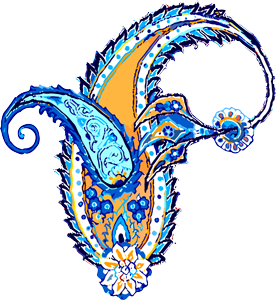
Travel Programme 6:
Iran integral, including Takht-e Soleiman
Tehran – Qazvin – Takht-e Soleiman – Hamadan – Bisotoun – Kermanshah – Susa – Chogha Zanbil – Ahvaz – Bishapour – Shiraz – Persepolis – Pasargadae – Yazd – Nain – Varzaneh – Isfahan – Abyaneh – Kashan.
17 days / 16 nights
Introduction

Introduction

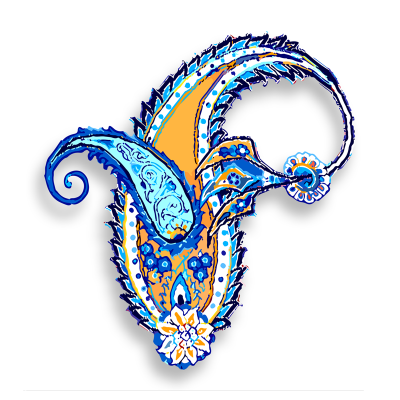
The trip,
day by day
Arrival at Tehran; transfer from IKA Airport and accommodation in a city-center hotel (Howeizeh or Enqelab hotel).
Today will be all about Tehran, the ever growing capital of Iran and the home to about 12 million residents, lying in the foothills of Damavand Mountain. We’ll visit the National Museum, developed in the 1930’s, which may be considered as a great introduction to the long history of Iranian civilizations.
When the Qajar dynasty took the control of the country in the late 18th century, they decided to move the capital to Tehran and its throne to the palatial complex of the Golestan (UNESCO), not far from the bazaar. The Golestan palace is a unique exemple of western influenced Iranian architecture dating back to the 19th century AD.
In order to complete this first day with Iranian culture, the Carpet museum will be the occasion to see a precious collection of handmade carpets, mostly from the 16th century up to the present showing the still living and evolving art of carpet-making in Iran.
We will finish the day in the Museum of Royal Jewelleries, located in the basement of the National Bank of Iran for security reasons. This fantastic collection includes precious stones and gems mostly collected since 17th century, notably the famous diamond of the Sea of Light and the crowns of Qajar and Pahlavi kings. Note that considering the nature of this museum with limited opening hours of only four days a week, this visit might be replaced with the Museum of Ceramics and glassware.
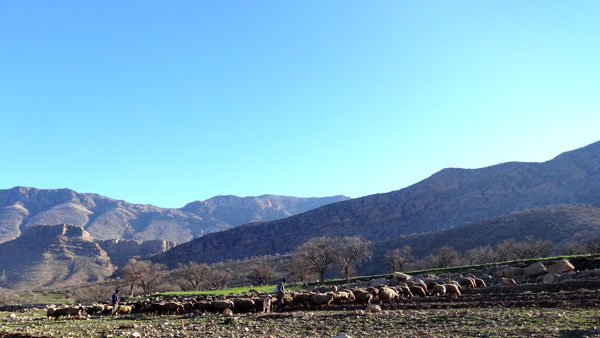
Departure toward Qazvin, one of the capitals of the great Safavid Dynasty in 16th century, visiting the great mosque of Qazvin, and the small shrine of Imam Zadeh Hossein. Continuing the route toward Soltanieh where the tomb of Sultan Mongol Oljaitu Khodabandeh (UNESCO) is located, with a blue dome of about 50 meters high.
Going 12 km south, we arrive at Viyar village where we will find a dragon rock-relief in the ruins of an enigmatic Ilkhanid period shrine known as Dash-Kasen in local language. We continue the road toward Takab for spending the night. Hotel Ranji (Rudimentary)
Occupied since the Achaemenid period, Takht-e Soleiman (UNESCO) is located on a volcano and became one of the most sacred fire temple during the Sassanid period known as “the Fire of the Warrior Kings”. This magnificent site has two main stages of development; the first in the Sassanid Period while it fnctionned as a royal fire temple and a second later one under Ilkhanid rulers.
After this visit we will take the road toward Bijar, entering the Kurdistan province, where we will have lunch and then visit its traditional Bazaar.
We’ll continue on the road toward Hamadan where we will spend the night but before arrival we will visit the Ali-Sadr cave, the most beautiful speleological ensemble in Iran
Arriving in Hamadan for spending the night in hotel Parsian / Buali.
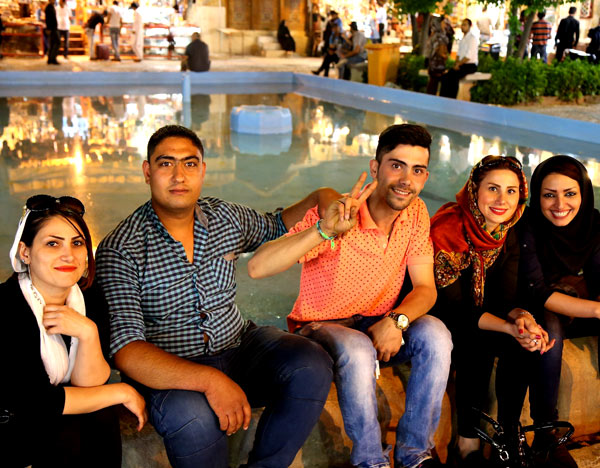
The morning visit will be spent in the small yet magnificent city of Hamadan. We start with a morning walk in the city center and photographing the daily life of people, on our way we will see the Revolution square of Hamadan located exactly at the center of the city and its surrounding buildings which remind us of 1920’s architecture. On our way we will stop by the Esther and Mordechai tomb, one of the highly-regarded pilgrimage centers of the Jewish faith. After the morning visit we will have a short visit to the funeral tower of Alavian, decorated with rich stucco work.
Hamedan is also well known as the old capital of the Median Empire, although this Median Capital has been never found, but the site of Tepe Hengmatameh includes a small museum about the history of the region and above all you can see there the trenches of archeologists from different periods and times in the search for the Median capital.
We leave Hamadan and take the road toward Kermanshah, on the way, we will visit Bisotoun (UNESCO) and the famous rock relief of Darius the Great.
Arriving in Kermanshah which is the home of many magnificent monuments and sites, we will first pay a visit to Tekiyeh Moaven Al Molk from the 19th century, a beautiful testimony to the political, religious and nationalist movements of that period. Finally, we will finish our day with the magnificent Sassanid site of Taq-e Bostan and its admirable rock reliefs.
One night stay in Hotel Parsian Kermanshah.
We will pass through the Zagros Mountains toward the Mesopotamian plain, arriving in the Arab region of Khuzestan and the centre of oil production and export. This is where we will visit the archaeological site of Susa (UNESCO), excavated by French archaeologists in the late 19th century which explaining the richness of Iranian History Hall in the Louvre museum. Susa is probably the most important archaeological Iranian site containing a long history since 4th millennium B.C up to the present time.
Not so far from Susa, we will find the impressive Ziggurat of Chogha Zanbil (UNESCO), constructed by king Untash-Napirisha in 1300 B.C and dedicated to gods Inshushinak and Napirisha. This is also the most well-preserved Ziggurat in the world.
Arriving in Ahwaz where we will spend the night in Oxin/ Parsian Hotel.
The early departure toward the province of Fars will lead us back in the direction of the Iranian plateau by passing through the territory of the Nomad tribe of Bakhtiari. Arriving at the border of Fars Province, in Kazerun county, we will visit two important Sassanid sites from the 3rd century A.D., first the city of Shapur I, known as Bishapur, constructed by Roman prisoners and not so far from its ruins, six important rock reliefs displaying for eternity important historical events held during the Sassanid period.
We will continue on the road toward Shiraz by way of a beautiful mountainous road.
Three nights stay in Shiraz, Zandieh/ Setaregan Hotel.
Today will be focused on the prestigious sites of the Persian antiquity. The morning visit starts with Persepolis (UNESCO), the great symbolic capital of the Achaemenid empire, founded by Darius the Great but the construction continued with his successors for two centuries, until the arrival of Alexander and its tragic ending. The great palaces of Apadana and One Hundred columns, the rock reliefs of the delegations, and the royal tombs are the opening pages of the ancient dynasty who ruled Iran between ca. 550 BC and 330 BC.
Just nearby, we will visit four Sassanid rock reliefs in Naqsh-e Rajab and the great necropolis of Naqsh-e Rostam, carved into the mountainside, where the four Achaemenid royal tombs look out onto a jaw dropping view. Approaching the site, the Sassanid rock reliefs narrate the stories of the victory and pride of the last pre-Islamic dynasty of Persia.
We’ll be back in the afternoon in Shiraz, the city of poetry and roses, beautiful women and just rulers. When visiting the tomb of Sa’di, the great poet of 13th century, and the tomb of Hafez, the poet of 14th century, we’ll spend a pleasant afternoon in the gardens of Shiraz where many Iranians come to pay tribute to their great poets.
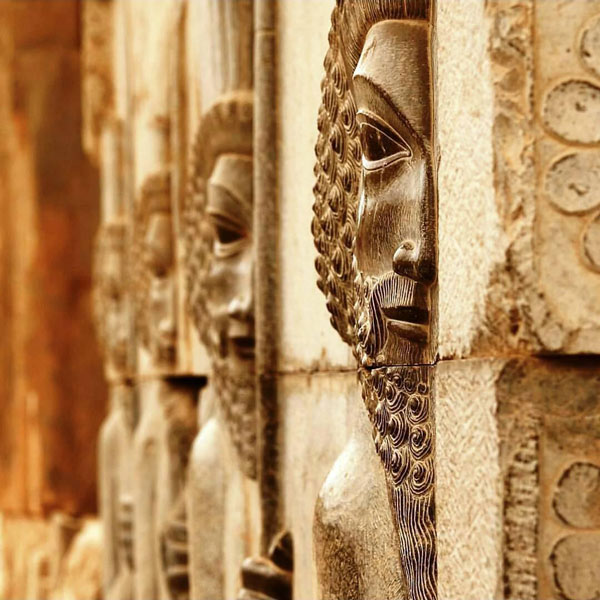
We’ll stay today in Shiraz, visiting a notable and very original 19th century mosque, Nasir al-molk mosque, famous for its stained-glass windows, the beautiful Qavam Qajar house, known as Naranjestan-e Qavam and the only remaining vestige of a Safavid period building (17th century) in Shiraz, the theological school of the Khan. We’ll then walk through Vakil Bazaar, full of the smells of spices and the colors of nomads’ traditional clothes, passing through the still- active urban caravanserais of Moshir and of the elephant, before arriving to Vakil mosque built in 1760 by Karim Khan, the founder of the short-lived Zand dynasty. His tomb is located just nearby, in a highly decorated pavilion built in the middle of a garden, not far from his citadel (Arg-e Karim Khan Zand).
The visit will end with a religious visit to the holy shrine of the lord of the light, Shah Cheragh, which is the burial place of the brother of the 8th Shia Iman, who died in Shiraz in the 9th century AD. It will be the perfect place to talk about Shia Islam and its surprising cult of the saints.
We’ll leave Shiraz behind just like the ancient caravans, and find ourselves on one of the sections of the legendary silk road before reaching the first Achaemenid capital, Pasargadae (UNESCO), which is famous as the location of the tomb of Cyrus the Great, the founder of the Persian empire.
On the road towards Yazd, Abarkuh is like an oasis on the edge of the desert where we can witness human creativity in adapting to a harsh climatic situation.
We will continue the road toward Yazd where many old oases are located that turned into small towns, such as Mehriz and its ancient citadel.
Finally, we will finish the day at the border of the desert, in a small and well restored Caravanserai, Zeinoddin Caravanserai, where we will spend the night.
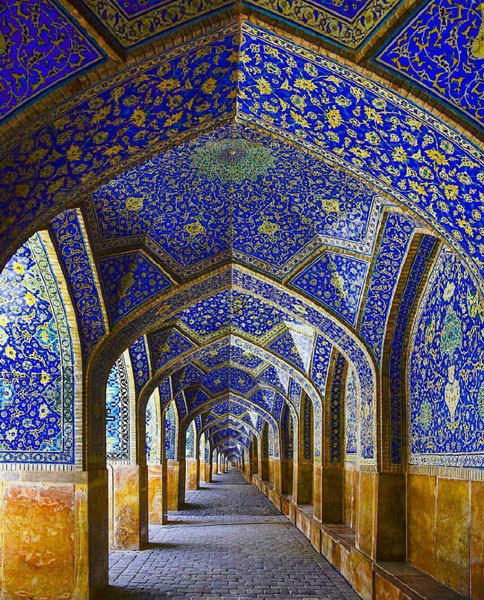
After looking at the desert sunrise and having an Iranian breakfast, we will drive 74 km toward Yazd to visit the city of wind catchers and Zoroastrians.
This day will be a good opportunity to get in touch with the Ancient Iranian religion, Zoroastrianism, and its current community, thanks to a visit to the small village of Cham and its isolated Tower of Silence. Back in Yazd, the main Zoroastrian center in Iran, we’ll visit its Fire Temple where, depending on the circumstances we may have a talk with a Zoroastrian Mobed / priest. Just before lunch, we’ll also have the opportunity to visit a lovely 18th century AD garden with the highest brick wind catcher in the world, the Dowlatabad Garden.
Yazd’s main attraction is its historical urban layout, one of the best preserved in Iran. We’ll get lost in the Old city, walking through narrow streets and its beautiful 14th / 15th century Friday Mosque decorated with gorgeous colorful glazed tiles.
We’ll end this very full day on the main square of Yazd and its Amir Chakhmaq complex.
One night in Yazd, Hotel Dad/Laleh/Safayeh.
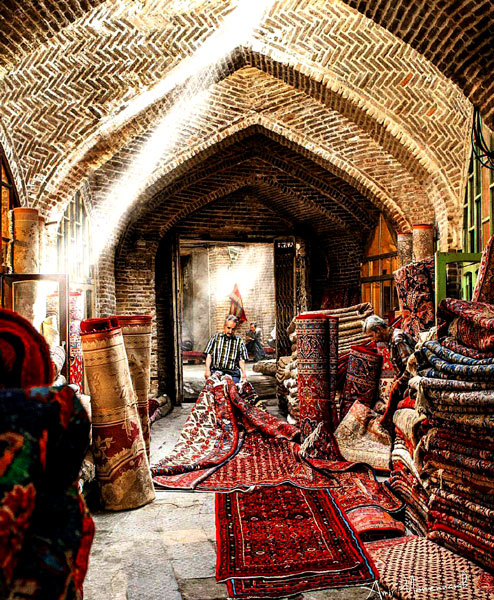
Departure toward the north to visit Meybod, an ancient citadel and a ice-house are the magnificent structures of the city as well as a caravanserai known as Shah Abbasi. Taking the road toward Isfahan province, we will visit Now Gonbad, a well preserved Caravanserai still on the edge of the present-day commercial route.
Riding toward the north, we arrive at Nain, a city with a rich monumental heritage including one of the oldest mosques of Iran with its splendid Minaret and a number of religious complexes dedicated to the martyr of Hussein, the grandson of the Muslims’ prophet. We will discover all of this in a pleasant walk through the narrow allies of the city.
On southwest of Nain, the city of Varzaneh, beside historical monuments such as the 15th century mosque and an ancient citadel, will be the occasion to enjoy the beauty of the desert through a walk on the dunes while watching the sunset.
Accommodation in a traditional house (note that this traditional house has the quality of a hotel while preserving its traditional style as well, therefore it is not a luxury hotel)
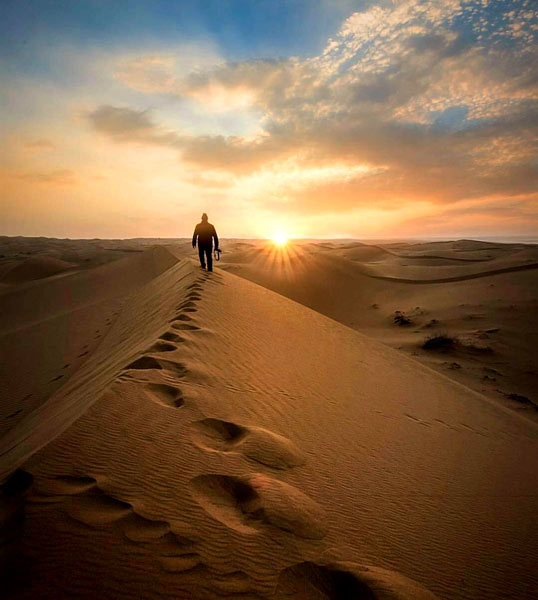
Isfahan was chosen as the capital of Iran in 1598 by Shah Abbas I. After this decision he started a great urbanism project for the city planning many palaces, gardens, mosques and royal monuments. The European traders witnessed in the 17th century the prosperity of Isfahan and called it the HALF OF THE WORLD, a city which competed with Paris, Rome and London at that time.
We will start the visit with the Armenian neighborhood, No Jolfa, and get familiar with the story of their immigration to Isfahan as part of the Safavid king’s plan to promote the city. After the lunch, the visit will continue in Jay, the ancient Jewish quarter which is now embracing one of the most unique mosques of the Islamic world, the Isfahan Friday Mosque (UNESCO), a monument with more than a 1000 years of history and architectural evolution.
Right beside the mosque is the ancient centre of the city, surrounded by traders’ boutiques and a Safavid period holy shrine, the Harun Willayat mausoleum located just nearby Ali Mosque.
Today will be focused on Safavid Isfahan with the Naqsh-e Jahan square (UNESCO), the mosque of Sheikh Lotfollah, the Royal Mosque, the Ali Qapu and Chehel Sotun palaces. We’ll enjoy some free time to end the day; which, if you wish, you can use for a pleasant stroll through the fascinating, historical Qeysariyeh bazaar, famous as an important handicraft center in Iran.

We continue the road toward Ardistan where we can admire the great mosque of the city with its unique architecture. In Natanz, is located the shrine of soufi master attached to a 14th century mosque with nearby a 6th century AD, pre-Islamic, fire temple.
We will finish the day in a mountainous village, Abyaneh, with its typical architecture and its inhabitants, that have still preserved their old customs.
One night in Hotel Abyaneh or Viyona.
Today will start with the visit of Abyaneh, walking through its alleys and meeting the locals.
Taking the car toward Kashan the city of rose water and traditional Iranian mansions. The visit will take the whole day and starts by the 16th century Persian Garden of Fin (UNESCO) to Tabatabai and Boroujerdi mansions and their love story.
We will continue the visit with one of the atypical mosques and theological schools of 19th century known as Madrasa Aqa Bozorg and will take a walk to the beautiful Bazaar of Kashan.
In the afternoon we will make our next stop in the airport hotel where we will have dinner and rest for the next morning flight back to home.
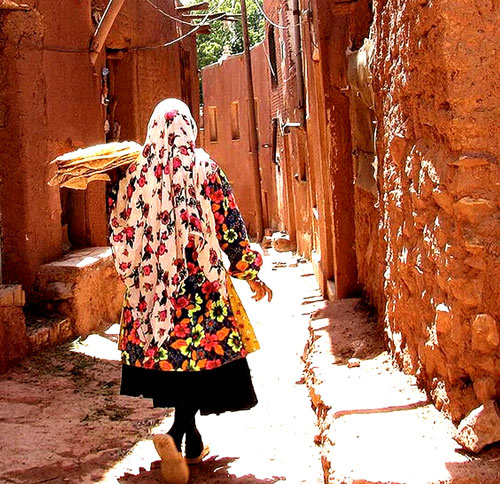
Taking the Return Flight.
Are you interested in this trip to Iran ?





